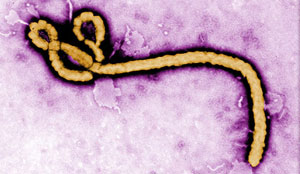Ebola Virus FAQ
 Frequently Asked Questions
Frequently Asked Questions
- What is Ebola?
Ebola Virus Disease (EVD), previously known as Ebola hemorrhagic fever, is a rare and deadly disease that is native to several African countries. It is caused by infection with Ebola virus, which is contracted through direct contact with a sick person’s blood or body fluids, contact with contaminated objects (such as needles), or contact with infected animals.
- Who is at risk?
Those at risk for EVD include:
- People who have resided in or traveled internationally to countries where cases of EVD have been reported (West African countries of Guinea, Liberia, Sierra Leone):
- People who have been in close contact with a person who is ill with EVD:
- People who have handled bats, rodents or primates from areas where EVD transmission is active; and
- Healthcare workers who have treated patients with EVD.
- What are the symptoms?
Symptoms include fever (greater than 100.4 degrees Fahrenheit), severe headache, joint and muscle pain, sore throat, weakness, diarrhea, vomiting, stomach pain, and unexplained bruising or bleeding. Some patients also experience skin rashes, red eyes and internal bleeding.
- When do symptoms appear after infection?
Symptoms can appear anywhere from 2 to 21 days after infection. The incubation period for EVD – the time from exposure to when signs or symptoms appear -- is usually 8-10 days, but can range from 2-21 days. The risk for transmission is greatest during the later stages of the illness. Ebola can only be transmitted when the ill person has symptoms.
- Is there a vaccine for EVD?
No vaccine currently exists for EVD.
However, the Department of Health and Human Services, including the Centers for Disease Control and Prevention (CDC), the National Institutes of Health (NIH) and the Food and Drug Administration (FDA) are leading the effort to develop and test vaccines and new treatments. Some investigational vaccines have been developed. The NIH recently announced that initial human testing of an investigational vaccine to treat Ebola would begin in September, and a vaccine developed through the U.S. Department of Defense also will start testing in humans later this year.
- How is EVD treated?
EVD symptoms are treated with supportive care, including providing intravenous fluids and balancing electrolytes, maintaining oxygen status and blood pressure, and treating other infections that may occur.
- What are the potential complications of EVD infection?
Data gathered on patients who have recovered from EVD show long-term complications ranging from joint and muscle pain to vision problems. EVD can potentially be fatal. Recovery depends on early diagnosis, good clinical care, and the patient’s immune response. Evidence shows that people who recover from EVD infection develop antibodies that last for at least 10 years.
- How can I prevent transmission?
Basic infection control procedures and good hygiene can prevent infection. Just like any other virus, EVD can be prevented by:
- Avoiding contact with people who are sick or display signs and symptoms that indicate illness, including sharing food, cups or eating utensils;
- Washing your hands frequently – or, if soap and water aren’t available, using an alcohol-based hand sanitizer with at least 60% alcohol;
- Avoiding touching your eyes, nose, and mouth with unwashed hands;
- Disinfecting your home and belongings regularly; and
- Covering your mouth and nose when coughing or sneezing, using a tissue or your sleeve or elbow (not your hands).
- An annual flu vaccine can help prevent the flu, making diagnosis of Ebola easier. The flu vaccine is the number one way to prevent the flu.
- What procedures is my hospital following to keep patients and the community safe?
Our hospital follows infection control procedures as recommended by the CDC and our state health department. Routine infection control procedures that are used to prevent the spread of any viral illness also can control and manage Ebola cases and ensure the safety of other patients in the hospital.
While we do not anticipate Ebola impacting our community, out of an abundance of caution, we have:
- Implemented new screening processes to identify patients who have traveled to countries affected by Ebola, or who have had contact with someone who has traveled to those countries;
- Practiced appropriate isolation procedures in the event a patient presents with symptoms;
- Evaluated our supply of personal protective equipment (PPE); and
- Distributed detailed guidance to all hospital staff regarding the appropriate steps to prevent the spread of infection and the proper procedures for handling a patient who has, or is suspected to have, an EVD infection.
- Is EVD a threat to my community?
The threat of a widespread outbreak of Ebola in the United States is very low.
- Hasn’t EVD spread to the United States?
On September 30, 2014, the CDC confirmed the first case of Ebola to be diagnosed in the United States in a person who had traveled from Liberia to Dallas, Texas. The patient had no symptoms when leaving West Africa but developed symptoms approximately four days after arriving in the United States. The patient sought medical care at Texas Health Presbyterian Hospital of Dallas, was evaluated and discharged, and later readmitted and tested for Ebola infection. His diagnosis was confirmed and attempts to control his infection, which was quite progressed, began. He died on October 8.
Two additional secondary cases of EVD were identified when two nurses who cared for the patient at Texas Health Presbyterian Hospital of Dallas developed symptoms. Both nurses were quickly identified and isolated.
In addition, a medical aid worker who volunteered in Guinea, one of the three West African nations experiencing an Ebola epidemic, and since returned to the United States tested positive for Ebola on October 23, according to the New York City Health Department laboratory, which is part of the Laboratory Response Network overseen by the CDC.
The patient has been notified of the test results and remains in isolation at Bellevue Hospital in New York City, one of eight New York State hospitals that has been designated to treat Ebola patients. A specially trained CDC team determined earlier this week that the hospital has been trained in proper protocols and is well prepared to treat Ebola patients.
CDC and public health officials are taking precautions to identify people who had close personal contact with the infected persons.
- How can I find out more information?
You may contact the hospital with questions, or talk to your doctor or primary healthcare provider. Our staff has received extensive training and guidance on identifying, managing and treating EVD. You also can visit the CDC Ebola site at https://www.cdc.gov/vhf/ebola/index.html, or the World Health Organization (WHO) Ebola virus disease (EVD) site at https://www.who.int/health-topics/ebola#tab=tab_1.
